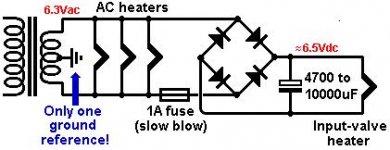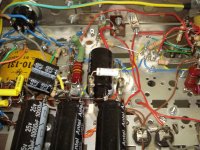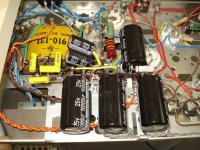
Newby question, this is my first use of a DC filament supply...
Using old fashioned trial and error...
I'm making a DC heater for a single preamp tube (one 6SN7) tube which draws 600 ma of filament current.
After rectification and filtering my supply is now delivering 7.34 volts with no load, the transformer is 6V and capable of 6A, bridge diodes, only a single 10000 uf capacitor as a filter, no RC filter. At my mains voltage the transformer outputs 6.54 volts AC.
(very similar to the schematic shown which came from valvewizard)
What is my (trial and error) design process here?
- Should I get the no load voltage dropped to 6.3 maybe by adding a series diode or two before I use this supply? Then just plug in the tube and go, Knowing there will be a slight voltage drop across the tube.
- Or should I first load my supply to 600 ma on the bench by selecting the proper resistor, then adjust things so the loaded supply is delivering 6.3 V? Knowing that the unloaded voltage will be slightly higher.
Basically which comes first the chicken or the egg?
Also in experimenting I've been careful to use a Variac and meter and test with a mains voltage that is true to what I actually have in my home. My mains are very stable here rarely going lower than 122 V or higher than 123 V.
I dont want to run the tube too hot or too cool, just right, maybe 5% tolerance.
I'd suggest a series resistance or an 7806 regulator to avoid the harsh peaks occurring
from the rectifier, but there might not be enough voltage for a regulator.
from the rectifier, but there might not be enough voltage for a regulator.
You need to loose 0.7v, 0.7/600mA = 1.16r, so try a 1r series resistor, but to your answer your question, option 2) is best.
Andy.
Andy.
If you going to use point-to-point wiring, you could use two stripped screw terminals so you can get to the right value by trial and error before soldering it in. I do calculate the value of the resistors first, but in my experience some fine tuning by trial and error is often necessary.
Attachments
Wire up the tube heater to the power supply and see what the loaded voltage is... usually tube heaters are designed for +-10% voltage variations, so you will probably find that when you connect the heaters, the voltage will drop and be within spec - no dropping resistor or regulator needed. I've run 12V on 6V heaters (oops) and other than the improved emission and brighter heater, the tube lived... If it's under 7V you should be good to go.
Last edited:
What DC voltage do you get with your load? It's not going to kill a 6SN7 to be exposed to 7.5V for 20-30 seconds. If you don't want to do this, use a 10 ohm 5W resistor as a temporary load.
This is important to consider because you haven't said anything about which diodes you used, and lossy diodes may give you enough of a drop on their own.
This is important to consider because you haven't said anything about which diodes you used, and lossy diodes may give you enough of a drop on their own.
What DC voltage do you get with your load? It's not going to kill a 6SN7 to be exposed to 7.5V for 20-30 seconds. If you don't want to do this, use a 10 ohm 5W resistor as a temporary load.
This is important to consider because you haven't said anything about which diodes you used, and lossy diodes may give you enough of a drop on their own.
I just grabbed some big old bridge package I had from a surplus buy because it takes gator clips easily. But I am going to be using higher current Schottke diodes I ordered, so voltage is going to be even higher. But I'm less confused now wondering if I should be targeting voltage first or current first, loaded, unloaded, etc. I do have a spent 6SN7 tube somewhere too I can use as a mule.
After the added series resistor for dropping the DC voltage, add another large shunt capacitor.
This will considerably decrease the voltage ripple across the filament.
This will considerably decrease the voltage ripple across the filament.
If you going to use point-to-point wiring, you could use two stripped screw terminals so you can get to the right value by trial and error before soldering it in. I do calculate the value of the resistors first, but in my experience some fine tuning by trial and error is often necessary.
Cool, I see what you did! I was over thinking it too much.
Basically I'm going to work with the closed loop by trial and error, using an old spent 6SN7, then choose a dropping resistor that gets me to 6.3 V across the heated tube. I was thinking of going at it from the open loop side, getting confused.
After the added series resistor for dropping the DC voltage, add another large shunt capacitor.
This will considerably decrease the voltage ripple across the filament.
Makes sense, I'd be halfway to another RC stage anyway!
- Home
- Amplifiers
- Tubes / Valves
- Design process for getting correct DC heater target voltage (newby)

